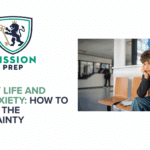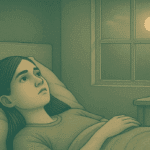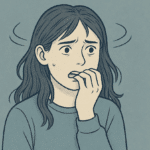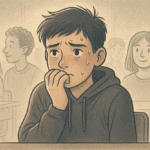Anxiety Journal Prompts: Tips for Tracking Triggers & daily Progress

Across the United States, teen anxiety is rising – and it doesn’t look like a phase. According to the National Institute of Mental Health, 31% of teens will experience an anxiety disorder before adulthood.¹ But while therapy and medication help many, there’s another tool that can quietly shift things over time, and that’s a daily anxiety tracking journal.
Keeping a structured log of thoughts, moods, and body cues gives teens something that anxiety often takes away, which is a sense of agency and control. When you track what’s happening on the inside, even in small ways, patterns start to emerge. What once felt random starts to make sense. And overwhelm becomes something you can observe, and sometimes even interrupt.
If anxiety is affecting your day-to-day life, a mental health professional can talk to you about options for regaining control over your mental health and well-being. However, if you feel like an anxiety tracking journal could help, this guide explores:
- What anxiety does to the teen brain
- Why journaling helps teens regulate emotions
- What teens should track (thoughts, triggers, body cues)
- Teen anxiety journal prompts that encourage insight and self-compassion
- Tips on building a journaling practice

What Anxiety Does to the Teenage Brain
Anxiety starts deep, in the wiring of the brain. And during the teen years, this wiring is still very much developing, which puts teens at heightened risk of developing anxiety disorders.²
The amygdala, which acts as the brain’s internal alarm system, becomes especially active in adolescence.³ This is a normal part of development, but in anxious teens, the alarm often goes off when there’s no real threat. For example, anxiety can spike when there’s a sideways glance, a silence, or a shift in tone.
Once triggered, anxiety doesn’t just stay in the mind. The signal travels quickly through the nervous system, releasing cortisol, tightening muscles, speeding up breath, and creating a full-body rush that makes it hard to think clearly.
Meanwhile, the prefrontal cortex (the part of the brain that helps with reflection, planning, and emotional regulation) is still catching up.⁴ In high-stress moments, this region often gets overwhelmed, leaving teens unable to explain what they’re feeling or make sense of why they reacted so strongly.⁵
Plus, when cycles of anxiety repeat, the brain adapts. The neural pathways linked to panic, shutdown, or spiraling grow stronger. An anxiety tracking journal can interrupt this cycle.
Tools like a teenage emotions journal or an anxiety tracking log help teens name what’s happening, link emotions to events, and slow the momentum. Each time they write, they’re not just expressing themselves; they’re strengthening the biological ability to manage emotions.
Therefore, an anxiety tracking journal can teach the brain that stress doesn’t always have to take over. Additionally, research shows that journaling can be cathartic and beneficial at all ages.⁶
Why Journaling Helps Teens Regulate Emotions
Inside the brain, a group of areas handles strong emotions like fear, sadness, anger, and joy. These areas are called the limbic system.⁷ The limbic system reacts fast – before words or logic. In teens, it’s especially active because their brains are still developing.
The part of the brain that’s slower to develop is the prefrontal cortex. However, when teens write about what they’re feeling, this region begins to wake up. ⁸ So, instead of staying stuck in emotion loops, they start to name what’s going on, helping to increase awareness and reduce out-of-control emotional reactions.⁹ Even a few lines in an anxiety self-reflection journal or a mood and anxiety journal can create this shift.
Journaling also helps teens track what triggers negative emotions. It can highlight what’s happening inside their bodies – like tension, tiredness, or early signs of panic – in response to a situation or event. In this way, journaling helps a teen create an internal map, allowing them to interpret their feelings in both conscious and unconscious ways.¹⁰
In fact, the more often a teen tracks their triggers and symptoms, the easier it gets to see patterns and respond thoughtfully instead of reacting emotionally.
Over time, this habit builds something deeper:
- Emotional regulation
- The skill of noticing without spiraling
- Responding without shutting down
Tools like a teen anxiety journal prompt list or a daily mental health tracker aren’t about fixing emotions. They’re about understanding them and coping with them better.
How Journaling Builds a Stronger Sense of Self in Teens
Adolescence is a time when identity starts to take shape, but anxiety can blur that process. When teens feel overwhelmed, their thoughts tend to spiral inward, making it harder to tell the difference between who they are and what they’re feeling.
A mental health journal for youth or a teenage emotions journal offers space to reflect without judgment and explore beliefs to come to more true conclusions about who they are. Over time, this kind of reflection supports a more grounded, confident sense of self.
Journaling supports identity development in teens by:
- Creating emotional distance: Writing about feelings helps teens observe them, rather than become them¹¹
- Reinforcing personal values: Journaling prompts often highlight what a teen stands for, not just what they’re struggling with¹²
- Supporting decision-making: Noticing repeating patterns helps teens understand what they want and what they don’t
- Building internal stability: A daily coping journal for anxiety helps teens return to their own thoughts, instead of relying on outside reassurance¹³
- Promoting self-trust: When teens track what works for them, they begin to feel more capable of handling hard moments
Daily Journaling Prompts and Templates for Teen Anxiety
For many teens, staring at a blank page can make anxiety worse, not better. Structure can help. Using a daily anxiety journal template or anxiety self-reflection journal gives just enough guidance. They can help teens name what they feel, track how it changes, and explore what helps without needing to come up with the perfect words.
But remember, whether you’re using a teen wellness journal, a mood and anxiety journal, or relying on prompts, consistency matters more than perfection.
Here are a few prompts and templates teens can try:
Daily Prompts for Anxiety Reflection:
- What’s one word that describes how I feel right now?
- Did anything happen just before I felt anxious?
- Are there any sensations I notice in my body?
- What thoughts keep repeating today?
- Is there anything that helped me feel a little calmer, even for a few minutes?
Weekly Self-Check Prompts:
- This week, I noticed my anxiety was worse when…
- I felt most grounded or safe when…
- One thing I want to try next week is…
- Something I handled better than I expected was…
Anxiety Trigger Tracker or Anxiety Symptoms Tracker:
To keep track of patterns, teens can jot down:
- The date
- What was happening when anxiety started
- What their body felt like in that moment
- The emotion they noticed most
- What they tried to help themselves cope
- Whether it helped or not
Over time, this simple anxiety log sheet or teen anxiety journal prompt list becomes a quiet support system – something that brings order to what often feels like chaos.
How to Help Teens Stick With an Anxiety Journaling Habit
Starting a journal is one thing – keeping it going is another. For anxious teens, the pressure to do it “right” can quickly shut down momentum. Yet consistency should come from comfort, not perfection. A journal for anxious teens works best when it feels like a safe space, not another task on the to-do list.
Encouraging a daily mental health tracker doesn’t mean journaling has to happen every single day. What matters more is regular, low-pressure engagement that builds emotional insight over time.
Here are a few gentle strategies that help:
- Let them choose the format: Some teens prefer writing in a notebook, while others might like drawing, voice notes, or keeping notes on an App
- Keep it short and approachable: A couple of sentences a day can be enough to build the habit
- Use prompts that match real life: When prompts reflect what teens actually go through, they’re more likely to use them
- Normalize inconsistency: Skipping days doesn’t mean failure. It just means they’re human and perhaps don’t have the mental energy to engage on certain days
- Connect it to something they value: Whether it’s managing social anxiety, improving focus, or feeling more in control – link journaling to what matters to them
Over time, this practice can turn a simple coping journal for anxiety into something more meaningful. It can become a personal anchor, a window into growth, and a quiet way to feel heard, even without saying a word.
Treatments Often Paired with Journaling
While journaling supports emotional awareness and nervous system regulation, it works best as part of a comprehensive care plan. At Mission Prep, we often pair journaling with other therapies to help teens manage anxiety, whether that means calming the body, rewiring thought patterns, or restoring a sense of connection.
Here are some treatments commonly combined with journaling:
- Cognitive behavioral therapy (CBT) to help teens recognize anxiety patterns and develop more balanced thinking¹⁴
- Trauma-informed psychotherapy to explore root causes and strengthen emotional resilience¹⁵
- Breathwork and mindfulness-based practices to activate the parasympathetic nervous system and reduce overwhelm¹⁶
- Family or caregiver support sessions to build communication skills and co-regulation strategies at home. Research shows that co-regulation can help teens and children handle big emotions better¹⁷
- Medication support, when appropriate, to help stabilize brain chemistry and reduce symptoms while teens build longer-term skills.
Journaling won’t replace therapy or medication, but it can amplify both by helping teens track their progress, process emotions, and feel more in control of their mental health journey.

Reach Out to Mission Prep for Advice and Guidance on Creating a Teen Mood and Anxiety Journal
Some teens don’t know how to talk about what they’re feeling to process their emotions. A journal gives them an alternative option. Journaling for teen anxiety doesn’t have to be long or poetic. It can just be a place to notice patterns, track rough days, or name what’s underneath the anxiety.
At Mission Prep, we work with teens and families to figure out what helps. Sometimes that’s journaling. Other times it’s breathwork, therapy, or just sitting with someone who gets it. We don’t believe in one-size-fits-all support.
If your teen’s been feeling overwhelmed, Mission Prep is here to help them build a steady foundation. Reach out for more help and advice today.
References
- National Institute of Mental Health. (n.d.). Any anxiety disorder. Retrieved July 10, 2025, from https://www.nimh.nih.gov/health/statistics/any-anxiety-disorder
- Xie, S., Zhang, X., Cheng, W., & Yang, Z. (2021). Adolescent anxiety disorders and the developing brain: Comparing neuroimaging findings in adolescents and adults. General Psychiatry, 34(4), e100411. https://pmc.ncbi.nlm.nih.gov/articles/PMC8340272/
- Scherf, K. S., Smyth, J. M., & Delgado, M. R. (2013). The amygdala: An agent of change in adolescent neural networks. Hormones and Behavior, 64(2), 298–313. https://pmc.ncbi.nlm.nih.gov/articles/PMC3781589/
- Tottenham, N., & Galván, A. (2016). Stress and the adolescent brain: Amygdala-prefrontal cortex circuitry and ventral striatum as developmental targets. Neuroscience and Biobehavioral Reviews, 70, 217–227. https://pmc.ncbi.nlm.nih.gov/articles/PMC5074883/
- Arnsten, A. F. T., Raskind, M. A., Taylor, F. B., & Connor, D. F. (2015). The effects of stress exposure on prefrontal cortex: Translating basic research into successful treatments for post-traumatic stress disorder. Neurobiology of Stress, 1, 89–99. https://www.sciencedirect.com/science/article/pii/S2352289514000101#:~:text=Basic%20research%20has%20found%20that,the%20amygdala%20and%20basal%20ganglia
- Koziol, C. (n.d.). Journaling’s impact on mental health. Journal of Undergraduate Research, University of Wisconsin-La Crosse. Retrieved July 10, 2025, from https://www.uwlax.edu/globalassets/offices-services/urc/jur-online/pdf/2021/koziol.callie.eng.pdf
- Torrico, T. J., & Abdijadid, S. (2025). Neuroanatomy, limbic system. In StatPearls. StatPearls Publishing. https://www.ncbi.nlm.nih.gov/books/NBK538491/
- Megumi, A., Suzuki, A., Yano, K., Qian, Y., Uchida, Y., Shin, J., & Yasumura, A. (2025). Developmental change of prefrontal cortex activity during handwriting tasks in children and adults. Brain and Development, 47(2), 104338. https://www.sciencedirect.com/science/article/abs/pii/S0387760425000191
- Lieberman, M. D., Eisenberger, N. I., Crockett, M. J., Tom, S. M., Pfeifer, J. H., & Way, B. M. (2007). Putting feelings into words: Affect labeling disrupts amygdala activity in response to affective stimuli. Psychological Science, 18(5), 421–428. https://pubmed.ncbi.nlm.nih.gov/17576282/
- Khalsa, S. S., Adolphs, R., Cameron, O. G., Critchley, H. D., Davenport, P. W., Feinstein, J. S., Feusner, J. D., Garfinkel, S. N., Lane, R. D., Mehling, W. E., Meuret, A. E., Nemeroff, C. B., Oppenheimer, S., Petzschner, F. H., Pollatos, O., Rhudy, J. L., Schramm, L. P., Simmons, W. K., Stein, M. B., … Interoception Summit 2016 Participants. (2018). Interoception and mental health: A roadmap. Biological Psychiatry: Cognitive Neuroscience and Neuroimaging, 3(6), 501–513. https://www.sciencedirect.com/science/article/pii/S2451902217302343
- Park, J., Ayduk, Ö., & Kross, E. (2016). Stepping back to move forward: Expressive writing promotes self-distancing. Emotion, 16(3), 349–364. https://pubmed.ncbi.nlm.nih.gov/26461252/#:~:text=One%20day%20following%20the%20intervention,illustrate%20how%20it%20does%20so
- Grégoire, S., Doucerain, M., Morin, L., & Finkelstein-Fox, L. (2021). The relationship between value-based actions, psychological distress and well-being: A multilevel diary study. Journal of Contextual Behavioral Science, 20, 79–88. https://www.sciencedirect.com/science/article/abs/pii/S2212144721000296
- Wurtz, H. M., Willen, S. S., & Mason, K. A. (2022). Introduction: Journaling and mental health during COVID-19: Insights from the Pandemic Journaling Project. SSM. Mental Health, 2, 100141. https://www.sciencedirect.com/science/article/pii/S2666560322000810
- Sauter, F. M., Heyne, D., & Westenberg, P. M. (2009). Cognitive behavior therapy for anxious adolescents: Developmental influences on treatment design and delivery. Clinical Child and Family Psychology Review, 12(4), 310–335. https://pmc.ncbi.nlm.nih.gov/articles/PMC2775115/
- Yadav, G., McNamara, S., & Gunturu, S. (2025). Trauma-informed therapy. In StatPearls. StatPearls Publishing. https://www.ncbi.nlm.nih.gov/books/NBK604200/
- Bentley, T. G. K., Seeber, C., Hightower, E., Mackenzie, B., Wilson, R., Velazquez, A., Cheng, A., Arce, N. N., & Lorenz, K. A. (2022). Slow-breathing curriculum for stress reduction in high school students: Lessons learned from a feasibility pilot. Frontiers in Rehabilitation Sciences, 3, 864079. https://pmc.ncbi.nlm.nih.gov/articles/PMC9397716/
- Salamon, M. (2024, April 3). Co-regulation: Helping children and teens navigate big emotions. Harvard Health Blog. https://www.health.harvard.edu/blog/co-regulation-helping-children-and-teens-navigate-big-emotions-202404033030



















